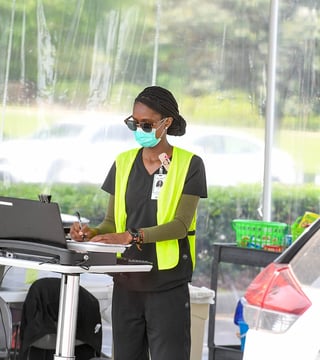
2020: A Global Pandemic
January Building a Responsive Plan
In less than six months after being named chief executive officer for South Georgia Medical Center, Ronald “Ronnie” Dean was tasked with leading the health system through its most challenging crisis—a global pandemic.
In January 2020, when the first documented case of SARS-CoV-2, the virus that causes COVID-19, was reported within the U.S., health officials had limited information on how the virus spreads, who the disease affects the most, and how to best combat transmission and provide treatment.
As the coronavirus continued to spread internationally and domestically, Dean quickly established a clinically-led response team, including Dr. Brian Dawson, Chief Medical Officer, and Randy Smith, Chief Operating Officer and Chief Nursing Officer.
“It was essential that we immediately enacted our Emergency Operation Plan (EOP), a framework for acquiring and disseminating useful information, making timely decisions, and allocating resources throughout our four-hospital system,” Dean said. “The execution of this plan would be critical to the team’s performance and necessary to combat the unknown and unprecedented healthcare delivery crisis.”
With immediate efforts focused on stabilizing SGMC’s current situation, Dawson said, “We needed to know what we were dealing with on the scene and how we could care for our patients and staff. Next, we had to get an assessment of our organizational capabilities to deal with a pandemic of this magnitude.”
Subscribe for updates Stay in the know.
Looking Inward
The internal assessment evaluated current policies and procedures, along with a deep dive into SGMC’s supply inventory, clinical space, bed capacity, and personnel.
“It was just a matter of time before the coronavirus reached us,” Smith said. “We started watching what was happening in Washington [where the first U.S. cases of COVID-19 were confirmed] and as it made its way to other areas.”
On March 11, 2020, SGMC escalated its EOP when a patient transferred to another hospital was confirmed positive with the coronavirus.
As the days, weeks, and months unfolded, the response team constantly anticipated its next steps and modified plans as the virus continued to change course.
“We were always trying to look around the corner,” Smith said. “It was important to find those unforeseen things that might not be readily obvious or might be happening at other hospitals.”
Cross-departmental communication was an integral part of SGMC’s clinical decision-making process. “We engaged our physician leaders from the medical staff with administration and nursing,” Dawson said. “We were able to put in place a multifaceted plan to deal with various aspects and consequences of the pandemic.”
Smith said the hospital’s leadership was accessible. “We were talking to the people most impacted and getting constant feedback on what was and wasn’t working. We had to make sure our team members were getting support and the resources to do what was needed. We also involved them in the planning, bounced ideas off them, and truly worked together.”
Managing Resources
From the start of the coronavirus pandemic, the shortage of personal protective equipment, also known as PPE, became a challenge for hospitals and healthcare facilities across the country.
Utilizing best practices in supply chain and operation management was instrumental in SGMC’s capacity to handle multiple surges of COVID-19 patients while also maintaining other hospital services.
SGMC decided early on to start conserving its existing PPE and began building a surplus of critical supplies.
“We anticipated what we needed and didn’t sit around waiting to see what would happen,” Smith said. “We didn’t know how long the pandemic would last, but knew even if we over-ordered, these were all supplies that would last and eventually be used.”
While the list of PPE is extensive, most notably in short supply were gloves, face shields, surgical and N95 masks, and gowns.
“We were burning through a lot of disposable gowns, and we knew at this level we wouldn’t be able to sustain our supply,” Smith said. “We looked outside the box to see what options we had for backup.”
As the materials management staff was scouring PPE sources for disposable gowns, SGMC started using reusable cloth gowns.
Thanks to a group of local volunteers, thousands of reusable cloth gowns were made.
SGMC purchased the material based on criteria established by infection control; "it was very light, which is important,” Smith said. “If you’re wearing a gown, face shield, and N95 mask for a long time it gets hot quickly."
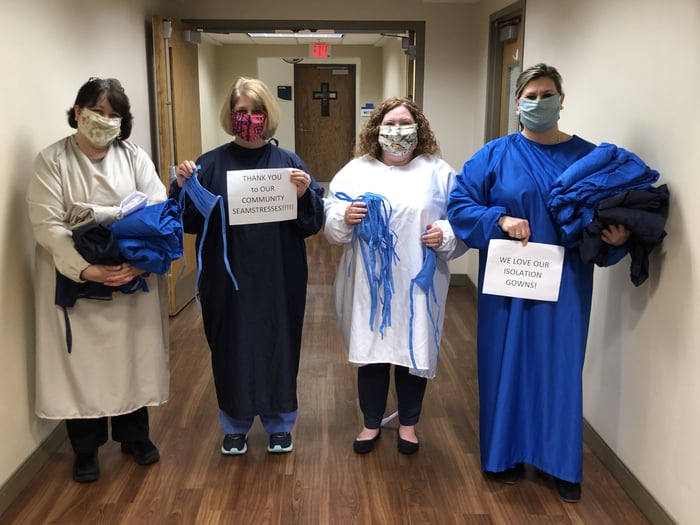
Shoring Up Infrastructure
With a focus on being proactive, on March 16, 2020, SGMC opened a COVID-19 drive-thru screening and testing site at its Smith Northview campus.
“There are several things we did really well. One was offering early COVID-19 screening and testing,” Dawson said. “Having the Smith Northview site up early and testing as many people as we did was a game-changer for this community, especially during the first wave.”
The drive-thru COVID-19 station allows community members to conveniently and safely receive a free assessment of their symptoms, and if necessary, receive a COVID-19 test.
With the anticipation that the emergency department would hit its full capacity, SGMC established a triage tent to coordinate care for a higher volume of patients with COVID-19 symptoms.
Opened in early April, the 1,500-squarefoot air-conditioned tent allowed medical personnel to evaluate potential COVID-19 patients and determine the next level of care.
“By expanding capacity in advance of a large patient surge, we were able to maintain control and provide the safest environment possible for all patients presenting to the emergency room,” said Dean. “And offer an equally safe environment for our workforce, both of which are our highest priorities.”
Managing the hospital’s bed capacity is handled through a staggered approach. “Once a unit fills up, we have another one ready,” Dawson said. “It’s a strategic process to have enough bed space, personnel, and supplies available to operate a unit. Through our clinically-led response team meetings, we have emergency room, nursing, surgery, and other departments around the table to talk about what’s happening and how to move forward.”
When hospitals across Georgia were battling to find beds to house patients during the various spikes in COVID-19 cases, SGMC utilized 45 beds at its Smith Northview campus.
The additional bed space provided SGMC with the option to safely place non-COVID-19 patients at Smith Northview and continue supporting the needs of COVID-19 patients at the hospital’s main campus.
Throughout the coronavirus pandemic, the varying spikes in positive cases forced some regional hospitals to divert patients to other hospitals. With its added bed space, SGMC accepted COVID-19 patients from regional hospitals that had reached capacity.
“I think this crisis has demonstrated that SGMC is a regional referral healthcare system,” Dawson said. “We have our doors open to other hospitals in our area that had difficulty with volume, and we were able to accept their patients to SGMC and care for them. We are the hospital’s hospital for smaller ones in the region.”
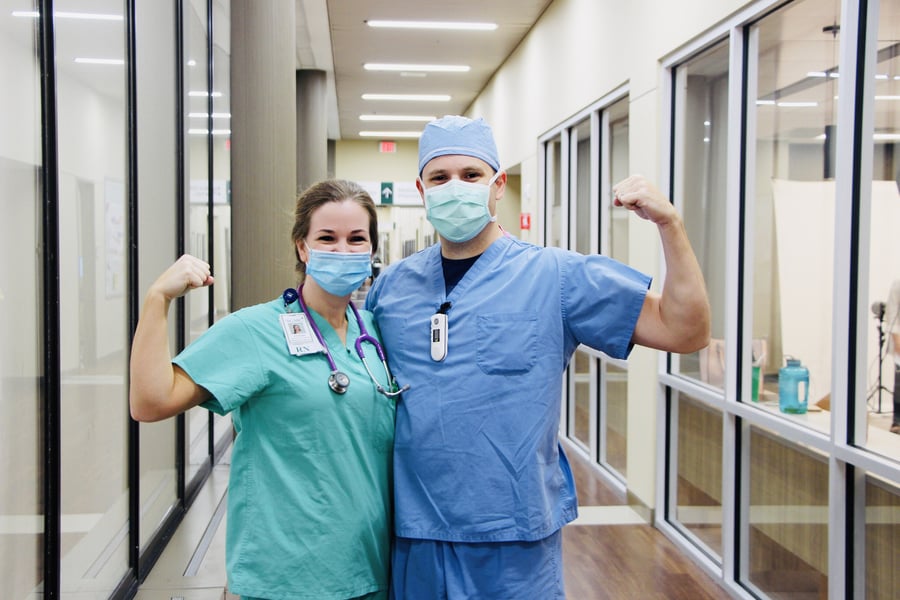
Staff Readiness
The issue of opening up bed space came with the need for more critical care nurses.
SGMC found a solution located across the street in Valdosta State University’s Health Sciences and Business Administration Building.
“I reached out to the VSU’s College of Nursing and asked for permission to use their simulation lab,” Smith said. “We needed to start up-training staff to take care of the higher level of patients because clearly, the need was to going to be in critical care.”
Due to COVID-19, VSU nursing students were taking classes online, leaving the simulation lab available for SGMC.
“We were able to train about 25 to 30 percent of our staff,” said Smith, who worked with LaGary Carter, VSU’s associate dean for the School of Health Sciences. “We completed the didactic classes here at SGMC and then walked over to Valdosta State’s simulation labs. The simulation provided a realistic view, and we were able to prepare our staff to take care of the critical level patients.”
SGMC also remained ahead of the nursing shortage with assistance from agency nurses. “Before COVID, we only had about six agency nurses,” Smith said. “Even before the COVID cases started to rise, we had these agency nurses on board, and then we added about 60 more,” specializing in emergency, intensive care, progressive care, and medical surgery.
Clinical Response
More than one year from the start of the COVID-19 pandemic, the spectrum of medical therapies continues to evolve rapidly.
“In the beginning, there were many things we didn’t know,” Dawson said. “We were using available information from the CDC [Centers for Disease Control], Georgia Department of Public Health, and academic institutions.”
“Our clinically-led response team formalized order sets that prescribed the type of treatments for patients,” Dawson said. “As a team, we sit down and discuss treatment options and strategies. Are there any new treatments that we need to include or old ones that need to come out or change to make them more efficient?”
On April 28, 2020, SGMC started providing COVID-19 positive patients with convalescent plasma as part of the Mayo Clinic’s COVID-19 Convalescent Plasma Study.
Convalescent plasma refers to blood plasma collected from people who have recovered from COVID-19 to treat patients with advanced symptoms of the virus.
As the second wave of COVID-19 patients began to emerge, SGMC was one of about 85 medical facilities in Georgia selected to administer Remdesivir.
In early December, SGMC administered its first infusion therapy after the FDA granted emergency use authorization for casirivimab and imdevimab. The monoclonal antibodies are given to patients who have tested positive for COVID-19, have mild or moderate symptoms, and are at a high risk of disease progression and hospitalization.
“It works to decrease the severity of the disease and helps prevent patients being admitted to the hospital by about 30 percent,” Dawson said. “This lowers the number of COVID-19 patients in our hospital, which allows us to save beds for more severe patients.”
As the COVID-19 vaccine was made available, SGMC was at the forefront of health systems offering convenient access.
On January 11, 2021, SGMC opened a COVID-19 vaccination drive-thru after Georgia expanded its eligibility to include citizens 65 and older, area law enforcement, firefighters, and first responders.
"We learned from our early COVID-19 testing drive-thru,” Smith said. “There were lessons learned that gave us the ability to start vaccinations immediately."
Moving Forward
With a renewed spirit of strength and resiliency, SGMC is forever changed due to the COVID-19 pandemic. Instead of looking at returning to a “new normal,” SGMC’s leadership understands there is still work that needs to be done to prepare for the next set of challenges.
Appreciating the lessons learned, Smith said, “Personally, it brought home how important the decisions are that we have to make as leaders. These decisions truly impact every member of the community.”
Dawson said it’s the importance of transparency and collaborating with community partners that has helped SGMC remain active in caring for people in need. “Ultimately, patients benefit from the alignment of physicians practices, the hospital, and other components of the regional healthcare system to form a more robust and streamlined delivery system.”
With work still left to be completed, Dean said, “As well prepared as we were as a singular healthcare system, it became readily apparent that as a state and nation, we still have much work to do. Our team of professionals have been remarkable. They were willing, they were capable, and desired to succeed at the highest level.”
Dean added, “During such a crisis, it became obvious that we were dependent on others, and what we realize now is that we need to conduct even more widespread multiagency planning to be better prepared for the next one.”
Despite the pandemic, SGMC continues to grow, welcoming new physicians to the area and aligning with established practices. As the region’s most comprehensive medical center, SGMC continues to develop its capability and services to enrich the lives of the community it serves.
February Gaining Success Through a Proactive Approach to Supply Management
From the start of the coronavirus pandemic, the need for more personal protective equipment, commonly referred to as PPE, has been a clarion call for hospitals and healthcare facilities across the country.
Healthcare professionals rely on PPE to protect themselves and patients from the spread of germs and infectious diseases. While the PPE list is extensive, most notably in short supply were gloves, face shields, surgical and N95 masks, and gowns.
When South Georgia Medical Center’s Emergency Operation Plan was enacted in January, the decision was made to conserve existing PPE supplies and build inventory.
“We started monitoring the hospital’s inventory of PPE as the virus was coming across Europe,” said Charles Freeman, SGMC’s Director of Supply Chain and Materials Management. “When the first cases were reported in the U.S., I started seeing shrinking supplies. We could order some items, but many products are manufactured in China and other countries that were already shutdown because of COVID-19, and some items were backlogged.”
Scarlett Rivera, SGMC’s Director of Quality Improvement Patient Safety, said using a proactive approach kept SGMC from reaching critical status with PPE inventory.
The longevity of the COVID-19 pandemic has been a challenge. “I don’t think anyone could anticipate the volume and longevity of COVID.,” Rivera said. “We learned a lot from H1N1 and put some processes in place that have helped.”
“Having dealt with SARs and N1H1 years earlier, we knew what was coming,” said Rivera, who has worked at SGMC for 33 years. “Thanks to Charlie [Freeman] and his staff, throughout COVID-19, we haven’t run out of equipment or supplies. We did have to be judicious with what we had.”
Randy Smith, SGMC’s Chief Nursing Officer, said utilizing best practices in supply chain and operation management was instrumental in SGMC’s capacity to manage multiple surges of COVID-19 patients, while also maintaining other hospital services.
"The hospital’s materials management team is constantly looking ahead and pre-ordering supplies early on,” Smith said. “Even during the second wave of COVID-19 patients, which was around Memorial Day, when other hospitals ended up short, we had what we needed to take care of our patients."
As SGMC was building its PPE inventory, members of the community stepped in to help, including a “sewing brigade” of individuals who made cloth reusable masks and gowns.
Freeman said the N95 masks have to be used when dealing directly with COVID-19 patients; however, the cloth masks were given to patients when they were discharged, and non-surgical areas of the hospital.
“The homemade gowns were a lifesaver,” Freeman said. “We were able to wash them after each use and save our supply of disposable gowns.”
Inspired by family members who are healthcare professionals, Mathew Garner, an Airman stationed at Moody Air Force Base, donated more than 100 face shields and 500 ear reliefs to SGMC’s Urgent Care and Pearlman Cancer Center.
Garner used a 3-D printer at home to make the shields, which take about 30 minutes each.
Freeman said the engineering department worked with SGMC’s doctors to research, design, and build a new shield device to protect health providers as they treat COVID-19 patients.
The shields were designed to reduce medical practitioners’ exposure to the virus, especially when intubation is required, which means placing a tube down the patient’s lungs to help them breathe.
During the intubation process, germs become airborne causing doctors and nurses to be exposed to the aerosols that might come from the patient’s mouth. The shields place a protective barrier to limit the spread of germs.
Keeping SGMC’s PPE supplies at an optimum level continues to be achieved through interdepartmental collaborations and innovation.
“During COVID, I worked closely with a lot of people and departments that I didn’t before,” Freeman said. “There are a lot of amazing people at this hospital. They stepped up and did what needed to be done.”
Rivera agrees that the collaboration was critical. “Many of the interdepartmental relationships existed before [Covid-19], and we were able to build on them, and everyone worked together. We care about the patients, and everything we do is for them.”
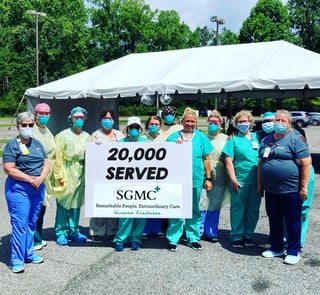
Community Benefits from Drive-Thru Screening Station
It was an early Saturday morning when Don Luke, Director of Operations at South Georgia Medical Center’s Smith Northview campus, got the call to have a COVID-19 screening site set up in two days.
“We needed to get this up as quickly as possible,” said Luke, who has worked at SGMC for 33 years. “I pulled together a small team and immediately went to a local store to buy pop-up tents.”
Support for the screening site reached beyond SGMC. “I called Ashley Tye, [Director of Lowndes County Emergency Management], to get orange cones and the Georgia Department of Transportation for a big electronic sign,” Luke said. “When I asked for help, people were there to do whatever we needed.”
The SGMC COVID-19 Screening Station opened at noon on Monday, March 16, 2020, and remains an active part of the health system’s pandemic response to screen and test for the coronavirus.
“When we started, we had strict screening criteria,” Luke said. “If they had symptoms like fever, coughing, shortness of breath, then they were evaluated by a physician who determined if a [COVID-19] test was needed.”
In the first few weeks, approximately 150 to 200 people per day came through the screening station, and on average, 3 percent received a COVID-19 test.
As the number of positive coronavirus cases increased, Luke said testing jumped to about 88 percent of the people screened. “We test based on the number of people who have symptoms or have been in direct contact with someone who is [COVID-19] positive.”
With a slew of new travel policies, requirements, and restrictions due to COVID-19 safety measures, SGMC adjusted its testing criteria.
“Around the holidays, we started getting more information from states about travel restrictions,” he said. “Air travel and some states were requiring proof of a negative test.”
Amid a post-Fourth of July surge, representing a one-day total, 363 people were screened, and 308 received a COVID-19 test. The highest post-holiday numbers came on January 4, 2021, when 531 people were screened, and 484 received a test.
It was a busy year, after nine months of operation [March-December 2020], 30,985 people were screened, and 25,127 received COVID-19 tests through the Smith Northview Screening Station.
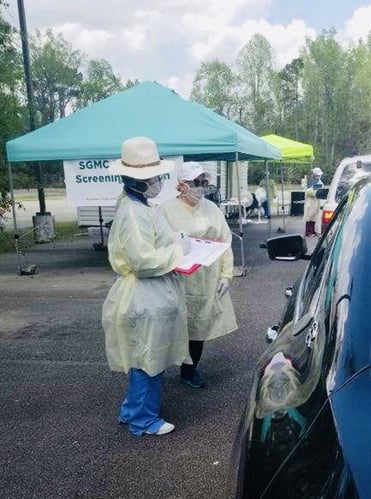

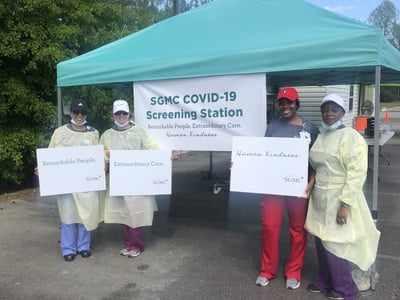
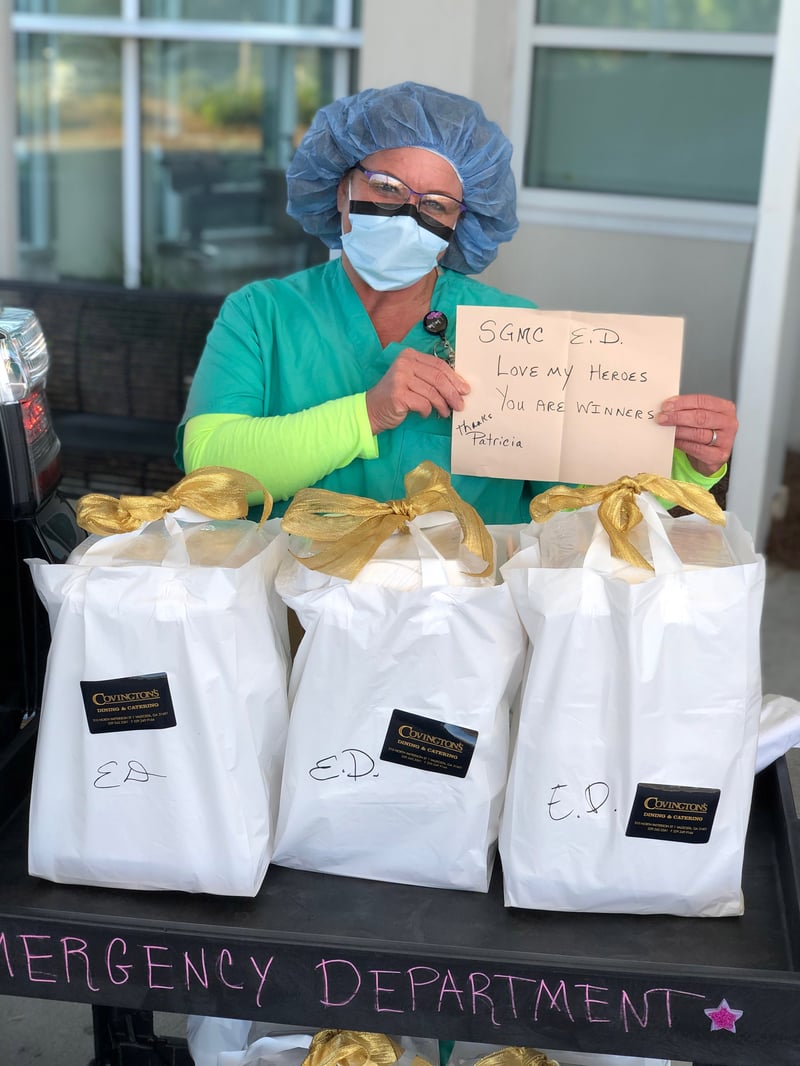
“The Smith Northview line has been a remarkable testament to what the people who work at SGMC can accomplish,” Luke said. “Every person who works at the drive-thru line is putting in hours outside their normal job. At every level, from housekeeping to engineering staff and nurses to phlebotomists, they stepped up and did what was needed to make this a success. They all have a desire to help the community.”
Luke said support from SGMC and the community has been overwhelming. “There were days in July and August when it was brutally hot, and some of our doctors rented outdoor air conditioning units to keep us cool. We had people bring us drinks and food. I think the community sees us as their hometown hospital. I started working here when I was 19 years old, and how we serve the community is personal to me.”
As the fears and the uncertainty of the coronavirus (COVID-19) escalated, like many small business owners, photographer Javon Longieliere had to contend with the economic impact of social distancing guidelines and event cancellations.
With time to spare, Longieliere said, “I didn’t want to sit around and become stagnant. I still wanted to be able to create, while bringing attention to frontline workers—a way to connect everyone to what was happening.”
He began using his creative talents to showcase unsung heroes and those deemed as “essential” workers in the fight against COVID-19. They were photographed in their work attire, along with a few props to capture the essence of their profession.
“These are people who couldn’t just call in and miss work because there was a pandemic going on,” said Longieliere, who has traveled the world as a portrait and wedding photographer. “If they did, the entire community would have fallen apart.”
Dubbed the “Hometown Heroes” project, Longieliere estimates he took more than 1,000 photos of people representing the broader definition of frontline workers. In addition to healthcare personnel and first responders, the images also represent teachers, food service workers, nonprofit staff, and the media.
According to South Georgia Medical Center Marketing Director Erika Bennett, Longieliere’s photos became part of the #SGMCStrong media campaign and was featured on billboards, printed publications, and social media posts.
“With this year’s unprecedented challenges, the entire SGMC team went above and beyond in the fight against COVID-19,” she said. “The Hometown Heroes campaign allowed us to bring attention to our frontline employees and thank them for their continued dedication.”
Longieliere said each image represents a unique and inspiring story. “It has been a learning experience for me, being able to get out in the community and meet people and talk about who they are and the impact they make.”
Approximately 50 of the portraits were featured during a two-week exhibit at the Turner Center for the Arts, and others will be part of Georgia’s historical archives.
“The Georgia Historical Society has contacted me to place the photos in their archives,” said Longieliere. “It’s about documenting the pandemic and showcasing the people who made a positive impact.”
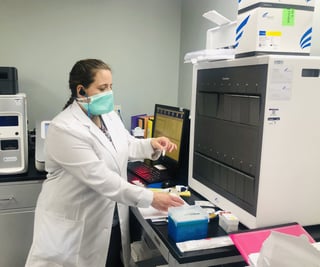
SGMC’S Lab Adds COVID-19 Testing Platforms.
When the number of coronavirus cases continued to rise, SGMC placed in-house COVID-19 testing as a priority.
As COVID-19 swept across the country, Angela Robinson, Director of SGMC’s Laboratory, kept a close watch. The complex COVID-19 testing issues posed multiple challenges, including a supply shortage of tests and a limited number of clinical laboratories authorized to process the tests.
When the number of coronavirus cases continued to rise, SGMC placed in-house COVID-19 testing as a priority. “At the start of the COVID pandemic, SGMC’s lab didn’t have FDA approved platforms for testing the virus,” Robinson said. “We had to send the test to national reference labs, which could take three to seven days.”
According to the FDA, diagnostic tests are used to determine if a person has an active coronavirus infection and should take steps to quarantine or isolate from others. There are currently two types of diagnostic tests—molecular tests, which detect genetic material through reverse transcriptase polymerase chain reaction (RT-PCR), and antigen tests, which detect specific proteins from the virus.
By mid-April, SGMC’s Laboratory had gained FDA Emergency Use Approval for the Biofire and Cepheid molecular testing platforms.
Robinson explained that BioFire and Cepheid represent the type of analyzer used to process the test. “Because we were already using BioFire, and then added Cepheid analyzers, we could start ordering more tests. It wasn’t enough to handle all the volume from the Smith Northview line. Still, it allowed us to rapidly test SGMC employees that might have been exposed, support surgeries, and patients admitted through the Emergency Department.”
Before the July Fourth Holiday, SGMC added the SOFIA IFA antigen test. “I was getting concerned because the cases were increasing, and I wasn’t sure if we would have enough of the PCR tests to get us through the weekend,” Robinson said. “Having the IFA antigen allows us to expand our testing capabilities. I can order more of the IFA tests, about 6,000 at a time.”
SGMC Chief Medical Officer Brian Dawson said having the in-house testing capability became a game-changer for the hospital’s ability to receive rapid results that helped accelerate clinical decision making.
"Being able to process the tests in the SGMC lab gives us results within a few hours, not days,” Dawson said. “Before, we had to treat all patients admitted to the hospital as if they were COVID positive until results came back. This limited where in the hospital they could be admitted. Did they need to be on a COVID unit? It also used up a lot of PPE [Personal Protective Equipment] sometimes unnecessarily.”
Robinson said SGMC’s Laboratory is now processing 99 percent of collected COVID-19 tests, representing 600 to 800 per day. “This includes tests for surgery, emergency room, hospital employee exposure, and the community screening line at Smith Northview,” as well as SGMC’s ancillary sites and affiliated physician offices.
“If a person is COVID-positive, providing same-day results gets them isolated earlier and helps stop the spread,” Robinson said. “If they are experiencing symptoms, they can contact their primary care physician or come to the Emergency Department for immediate follow-up and treatment.”
A “War Room” Approach
A logistical challenge, Robinson said, “How we manage the supply of tests has been a juggling act from the start. It’s important to test patients and support services like surgeries and get people on the right course for care.”
Displayed prominently in her office, Robinson has a large whiteboard with “COVID War Room” written boldly across the top. “From the very start of COVID, we started working with our sales reps to maintain and build our testing supplies. We never reached a point where we were entirely out of tests.”
Each day, Robinson takes an inventory of COVID-19 tests available. “We have a good utilization process,” she said. “I know how many tests I have and when more are coming.”
Working in tandem with Dawson and Gregory Beale, SGMC Medical Director of Infection Prevention and Control, Robinson said, “With our earlier limited supply of tests, Drs. Dawson and Beale developed strict criteria that patients had to meet before receiving a COVID-19 test.”
The entire COVID-19 response provided lessons in team building. “I think SGMC is much stronger now,” Robinson said. “We had to join together and survive together. It caused us to break down the silos and become a more cohesive team.”
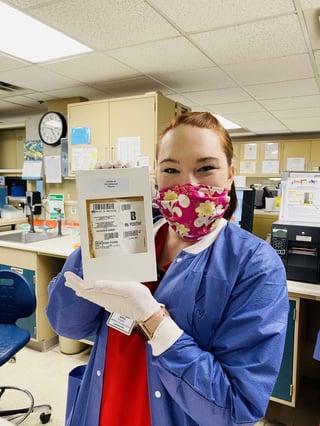
SGMC Becomes Mayo Clinic Study Site.
Convalescent Plasma Study.
South Georgia Medical Center participated in the Mayo Clinic’s COVID-19 Convalescent Plasma Study. On April 28, 2020, SGMC treated its first COVID-19 positive patient with convalescent plasma, which is blood plasma collected from people who have recovered from the coronavirus.
The Mayo Clinic serves as the lead institution providing coordinated access to investigational convalescent plasma for hospitalized patients with severe or life-threating COVID-19, or those who are at risk for the development for severe illness as judged by their doctors.
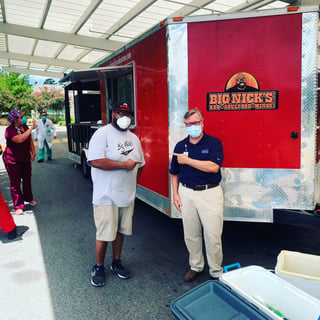
Community Provides Meals for Frontline Workers.
An overwhelming response.
When the COVID pandemic began to unfold, people were looking for ways to support local healthcare professionals.
“We had businesses and individuals wanting to help, but didn’t know how,” said Elizabeth Vickers, Executive Director of the SGMC Foundation. “It started with a few people dropping off meals for nurses working on the COVID floor. It grew quickly, and I realized that we need to have an organized process.”
Through the SGMC Foundation, Vickers developed the “Feed our Frontline. Support Local Restaurants” program. An online registration form allowed individuals and businesses to sponsor a meal, with the option of selecting a local restaurant.
“People had a chance to provide meals for nurses, while at the same time they were helping our local restaurants that were struggling,” Vickers said.
As more individuals and businesses donated, SGMC was able to provide meals to more departments and personnel.
“At first, we were feeding 25 to 30 nurses; then it jumped to more than 150 per day as shifts rotated in and out,” she said. “The nurses were extremely grateful. They were working long hours and filling in when others got sick. Plus, the process they had to go through [changing out masks and gowns] each time they left a COVID patient’s room was time-consuming—they didn’t have time to leave the floor to go eat.”
While not all doctors, nurses, and healthcare staff worked directly with COVID patients, Vickers said, “At some point, every SGMC employee was dealing with the stress of COVID. We had housekeeping and maintenance staff continuing to work on the COVID floors, food service was bringing meals to the patients, and people were being pulled from other floors to meet demands.”
With an overwhelming response, Vickers said more than 100 individuals and businesses contributed to the meal program. “SGMC is here to serve and take care of people, and we found ourselves on the receiving end. We have a very generous community, and when we present a need and ask for help, this community always steps up.”
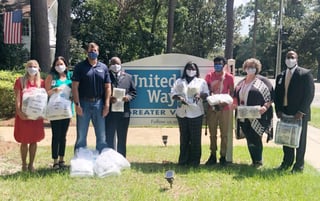
SGMC Helps Community Mask-Up
South Georgia Medical Center stepped up to do its part to fight the spread of the coronavirus. Through its “10K Mask Challenge” fundraising appeal, the SGMC Foundation raised $30,000 to purchase reusable cloth masks for children and adults in need.
“We know that there are people in our community who will follow the recommendation of wearing a mask in public places but simply don’t have access to one,” said SGMC Foundation Executive Director Elizabeth Vickers. “Over 75 donors, individuals, and businesses stepped up during this short time frame and helped us fill this need with monetary support. Our community truly knows how to give back.”
The Greater Valdosta United Way distributed 5,000 masks to its 19 partner agencies in Berrien, Brooks, Echols, Lanier, and Lowndes counties. Additional masks were distributed to patients discharged from SGMC, nonprofit agencies, local school systems, after school programs, and migrant farm camps.
“We were honored to partner with SGMC to distribute masks out in the community through our partner agencies,” said Michael Smith, Executive Director of Greater Valdosta United Way. “SGMC is a great partner of ours, and we are proud of their leadership in keeping South Georgia safe.”
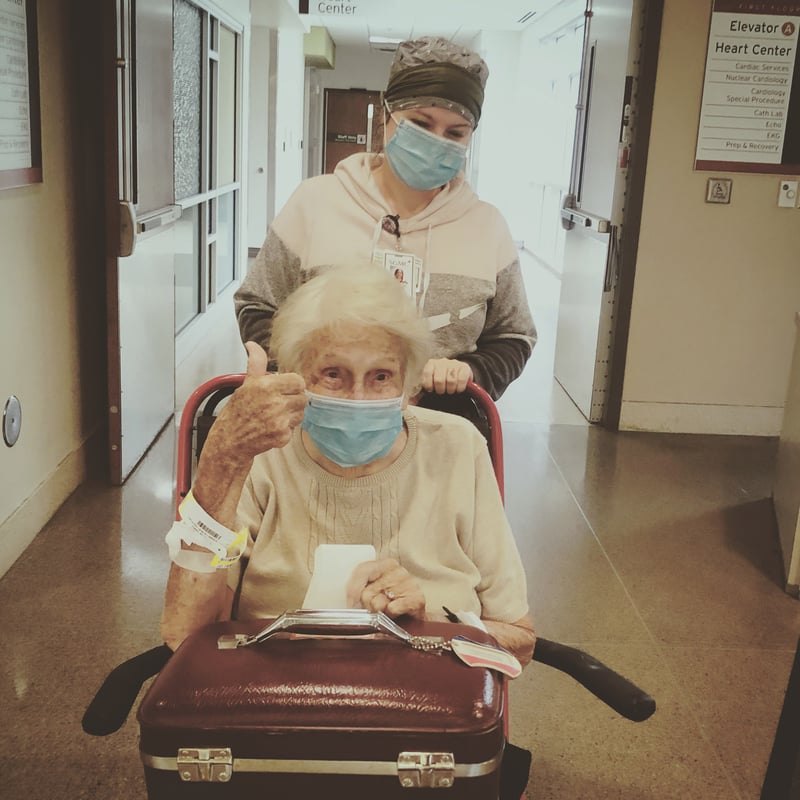
September 97 Year Old Discharged Home
Hilda became one of SGMC’s most seasoned patients to be hospitalized with COVID-19 and discharged home at the age of 97.

Finding Strength Through COVID-19.
Jenna Bolling’s story.
Jenna Bolling, a 32-year-old wife and mother of two young boys, Jaxson and Hudson, learned the importance of faith, family, and friends during her battle with the coronavirus.
A first-grade teacher at Lanier County Primary School, Bolling was looking forward to the start of the new school year, but that all changed when Jaxson, 7, was the first in the immediate family to test positive for COVID-19.
The next day, Bolling started having mild symptoms and tested positive for COVID-19. The following week, Hudson, 3, and her husband, Chris, started having COVID symptoms. “Hudson ran a fever, so we just assumed he had it as well,” she said. “Days later, Chris lost his taste and smell and tested positive.”
While thankful that her husband and sons had mild symptoms, Bolling, who was 24-weeks pregnant, sought immediate medical attention when she started having trouble breathing. “We had just had another community member die from COVID, so I was very nervous.”
On Aug. 22, when Bolling’s condition worsened, she went to the Emergency Department at South Georgia Medical Center’s Lanier Campus.
“I woke up that night gasping for air,” she said. “When I arrived, my oxygen level was 88 percent. They felt like I had pneumonia and wanted to do a chest X-ray, but because I was pregnant, I was placed on supplemental oxygen and transferred to SGMC’s main campus to be admitted.”
At SGMC, under the care of a team of doctors, nurses, respiratory therapists, and other specialists, Bolling responded to treatment that included high-oxygen flow therapy, the antiviral medication Remdesivir, and convalescent plasma therapy.
“Before the emergency C-section, I felt that she was improving,” said Dr. Gregory Beale, a pulmonologist at South Georgia Medical Associates. “Her main risk was the pregnancy, which is an immunological state that was causing her immune system not to work the way it should.”
On Aug. 28, when complications from the pregnancy escalated, Bolling had an emergency C-section.
Weighing one pound, seven ounces, Bryson James was delivered and immediately transported to Macon’s Navicent Health.
“Bryson died the same day; he only lived 20 hours,” Bolling said. “I noticed the C-section took longer than my two previous ones. Later I found out my placenta ruptured.”
With everything happening very quickly, Bolling said, “Chris wasn’t able to be with me in the delivery room, but they allowed him to see me on 2T [COVID floor] before I was rushed to the operating room.”
While dealing with the emotional stress of losing a child, Bolling said she became even more determined to fight COVID-19. “I turned to God even harder for strength. I knew I had to get better to go home to my family.”
As her respiratory condition continued to decline, Bolling was placed on a ventilator. “Before Dr. Beale put me on the ventilator, I asked him if I was going to die,” she said. “He said, ‘Not today!’ He reminded me of this once in rehab and in his office. He said, ‘He will never forget it.’”
Days later, she was life-flighted to the University of Florida Health Shands Hospital and placed on ECMO (extracorporeal membrane oxygenation) machine to support heart and lung functions.
“I don’t remember a lot of what happened,” she said. “From my understanding, when I was transferred to Shands, I was still COVID positive. Chris and my parents traveled to Gainesville and rented a hotel but could not see me.”
On her fourth day at Shands, Bolling received a negative COVID test, and Chris was able to be in her hospital room. “Shands would allow one visitor at a time, and it had to be the same visitor the whole time. He never left my side other than to eat and shower.”
Continuing to fight back, Bolling said, “Spiritually, I got closer to the Lord because I was always praying. Even Chris and I became closer as we prayed together.”
When her oxygen levels improved, Bolling was discharged from Shands and returned to SGMC to begin inpatient rehabilitation.
Subscribe for updates Stay informed.
Gaining Strength
“When I arrived at SGMC for inpatient rehab, my body was very weak from being in the hospital bed so long,” Bolling said. “Along with learning to walk, I had to relearn how to stand, sit up in the bed, roll over on my side, raise my legs, sit down with control, shower while monitoring my oxygen level, and even fixing my hair and makeup.”
Her rigorous inpatient rehab schedule included three hours per day, five days a week of physical and occupational therapy.
“Saturday is an optional day for therapy,” she said. “I told them to give me all the days because I wanted to get better and go home.”
Each day, she made significant improvements. “When I came to rehab, I couldn’t walk,” Bolling said. “I used a wheelchair, then a walker, a rollator, then a cane. It was an amazing feeling when I was finally able to walk on my own, even if it was just a few steps.”
Bolling credits the SGMC’s inpatient rehab team with her ability to walk again. “I received exceptional care. They became family. They knew what kind of day I was having and would encourage me, prayed with me, laughed, and even cried with me. They pushed me to do my best. They were some of my biggest cheerleaders, and I am forever thankful for them.”

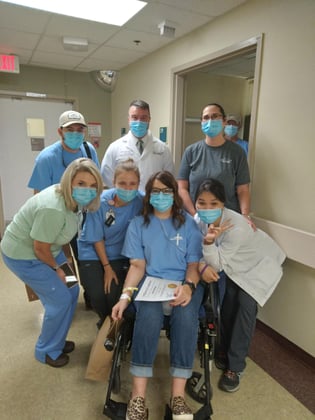
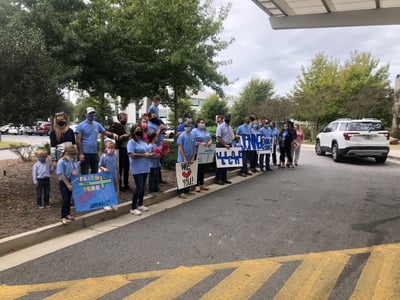
Homecoming
On Nov. 5, after a combined 75 days in the hospital and inpatient rehab completed, Bolling was finally going home.
Still using supplemental oxygen, Bolling was wheeled through the halls of SGMC as doctors, nurses, and staff “clapped her out” as she was reunited with her sons and family members.
The celebration continued as Bolling arrived back home in Lakeland. “On the day of my discharge, I was so emotional,” she said. “I never expected anything like what I saw. People lined the streets holding signs and cheering as I went by. I felt like a celebrity. All I could do was smile.”
Among the crowd of well-wishers were some of Bolling’s students. “It was the kids that really tugged at my heartstrings,” she said. “The excitement on their faces, their waves, them shouting my name caused me to get chill bumps, and tears flowed. All I could do was cry. I live in the best community and love my small town. It truly touched my heart to receive so much support.”
Bolling admits the days and weeks often seemed like a blur and is thankful that her sister, Jessica Mullis, a registered nurse at SGMC, kept a timeline of her recovery on Facebook.
“There were many days that I didn’t know what was happening,” Bolling said. “The Facebook prayers and words of encouragement played an important role in my fight. It gave me hope. It showed me that there were people all over the world praying for me, and I did not want to let them down. It gave me strength.”
As Bolling continues outpatient rehab, there are still days of discouragement. “Throughout, I have had good days and bad days,” she said. “I always try to focus on what I can do today and what I couldn’t do yesterday, or even last week or month.”
Her next goal is to return to the classroom. “I definitely think all of this will make me a better teacher when I am able to return because I miss it so much,” she said. “I will appreciate the job so much more and never take it for granted.”
Bolling is grateful for the entire SGMC team. “When I arrived at SGMC 2T [COVID floor], I received exceptional care from awesome nurses and doctors,” she said. “Dr. Beale saved my life. SGMC Inpatient Rehab helped me walk again. I am forever grateful.”
When asked what lessons she learned, Bolling said, “God healed me. The power of prayer carried me. Chris never left me, and my boys gave me a purpose. My sister advocated for me, my family supported me, and my community cheered me.”
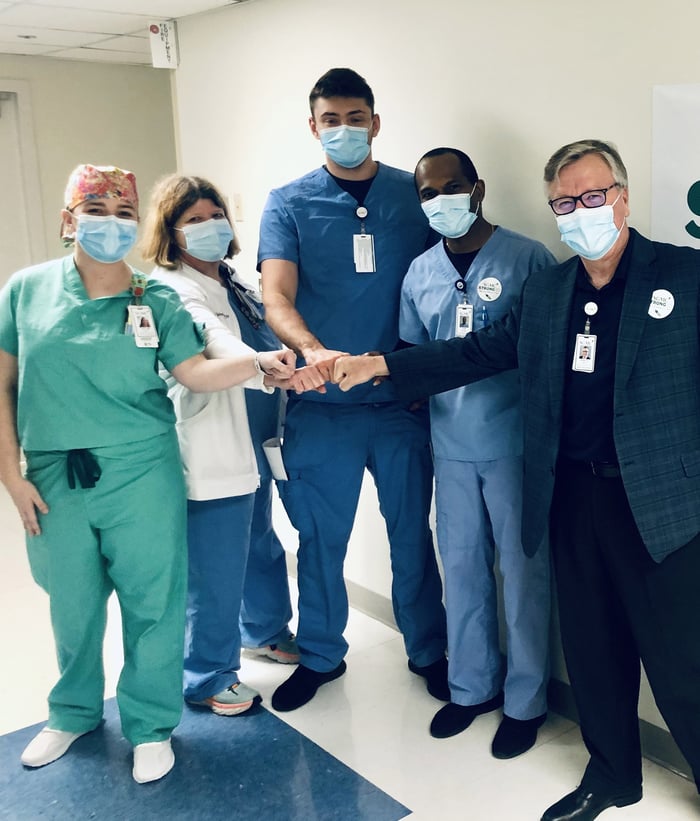
December Started COVID-19 Employee Vaccinations
South Georgia Medical Center began employee vaccinations on Dec. 21. It was a joyous day for the health system as a sense of hope was felt by all.



